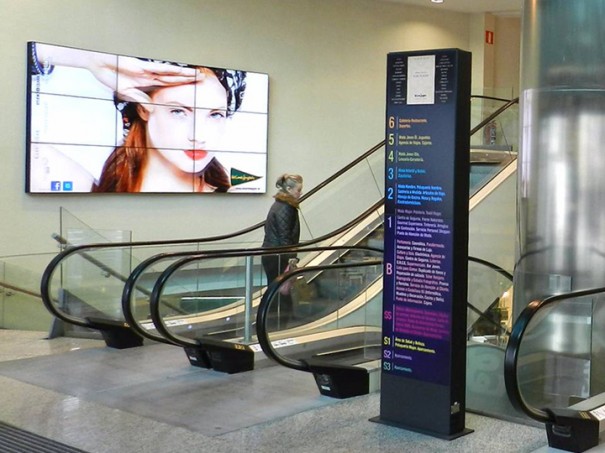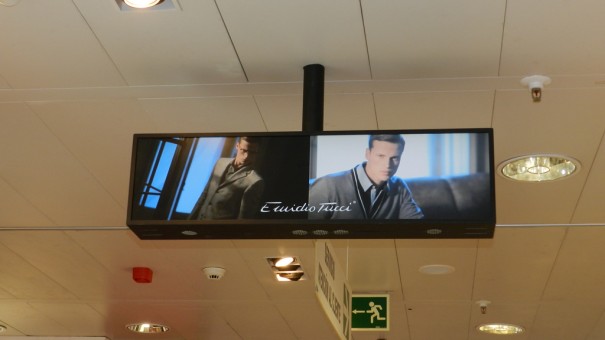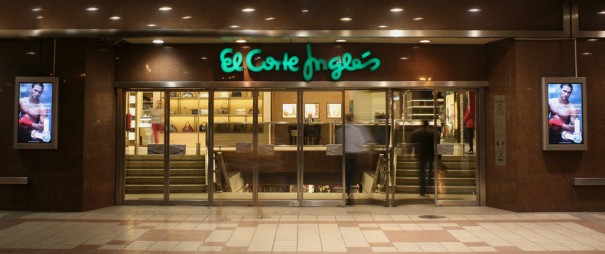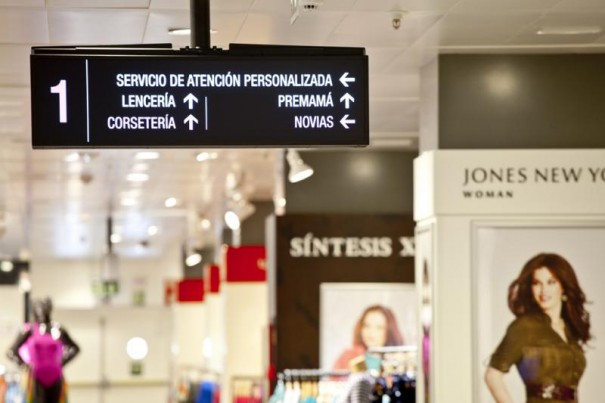The English Court digitizes its posters
Inves ha suministrado a los centros comerciales de El Corte Inglés dispositivos de cartelería digital personalizados hasta el último detalle para la emisión de publicidad propia y de marcas que se venden en los propios establecimientos.
Ayudar y orientar a los clientes en sus recorridos por el interior del centro y guiarles en la búsqueda de los departamentos y dependencias, comunicar y recordar a los visitantes las campañas comerciales en curso, etc, todo ello resuelto hasta el momento con elementos estáticos, son sólo parte de los motivos por los que El Corte Inglés, siempre atento a las novedades tecnológicas que puedan ayudar en su actividad comercial, ha puesto en marcha la implantación de estos dispositivos de publicidad e información dinámica.
El Corte Inglés ha implantado soluciones de cartelería digital en sus centros comerciales, después de la realización de estudios de valoración, con el objeto de aprovechar las ventajas que ofrecen este tipo de dispositivos y cubrir los aspectos antes mencionados además de crear circuitos publicitarios para ofrecer a las marcas de los productos en venta, que hasta ahora habían realizados con cartelería convencional estática.
Ventajas cualitativas:
Los beneficios identificados en el uso de la tecnología digital frente a los paneles estáticos son claros:
-Eliminación de los elementos de papel, metacrilatos, vinilos, etc. what, como componentes de un solo uso, una vez transcurrido el período de validez, deben ser retirados, desechados y sustituidos por otros nuevos.
-Eliminación de la compleja logística de impresión y distribución de dichos elementos que suponen elevados costes corrientes.
-Eliminación de las tareas manuales de montaje y desmontaje, que deben hacerse en horas nocturnas interfiriendo con las actividades diarias de reposición de mercancía y que también son costosos.
-Flexibilidad de los contenidos, que pueden ser modificados sin más coste que el de su creación.
-Inmediatez y simultaneidad en su presentación: una vez tomada la decisión de ser mostrados pueden ser enviados al momento y a la vez a todos los dispositivos de visualización afectados.
-Dinamismo. Un panel estático siempre muestra la misma imagen durante el tiempo que permanece expuesto. En uno digital se puede ir variando el contenido por franjas temporales tan pequeñas o grandes como se desee. Permitiendo, For example, ir cambiando el idioma de los textos sobre la misma imagen, o reproducir vídeos o imágenes en movimiento, imposible en los estáticos.
-Atracción para captar mejor la atención. La notoriedad y efectismo de las pantallas digitales junto con el dinamismo de los contenidos mejoran la percepción del consumidor.
-Sustitución de gastos por inversión, que puede ser amortizada en función del período de retorno de la inversión esperado.
-Mejora de la imagen corporativa, transmitiendo calidad y modernidad, acorde con la percepción que los clientes tienen de la empresa.
Partes integrantes:
Dejando al margen la actividad de creación de contenidos que, en cualquier caso, es común a la cartelería estática y está, therefore, ya resuelta, para la puesta en marcha del proyecto digital se requiere la disposición de los siguientes componentes:
· Repositorio (servidor) donde se almacenan los contenidos que han de ser distribuidos para su presentación.
· Aplicación de gestión de contenidos, que permitirá organizarlos, combinarlos, programarlos en parrillas de matrices de tiempos y dispositivos, y distribuirlos a los puntos de reproducción, junto con las indicaciones de horarios y permanencia. A la vez, esta aplicación permite ejercer control sobre los dispositivos para verificar que funcionan según lo previsto.
· Dispositivos de visualización, constituidos por pantallas de distintas tecnologías y tamaños y paneles de módulos LED para grandes dimensiones (paredes, facades).
· Reproductores, ordenadores personales de tipo industrial que generalmente van integrados dentro de las pantallas de visualización y que se ocupan de recibir los contenidos, que le han sido enviados por la aplicación de gestión, and?, gracias a un programa de reproducción, se encargan de mostrarlos en la pantalla según las indicaciones de horarios y duración.
· Red de comunicación para conectar los servidores repositorios de contenidos, con los ordenadores reproductores integrados en las pantallas de visualización. La red se puede establecer con medios físicos (cable de fibra óptica) o inalámbricos (Wi-Fi o módems 3G).
Los proyectos
Los “mupis”
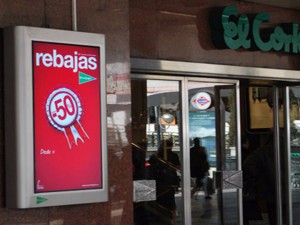 La primera fase de la puesta en marcha de la implantación digital se centró en la instalación de pantallas de semi-intemperie, “mupis”, en el exterior de las puertas principales de acceso de los centros comerciales más importantes. Con ellas se configuró un primer circuito publicitario, gestionado por In-Store Media, con objeto de ser ofrecidas como soporte digital publicitario a las marcas de los productos comercializados en El Corte Inglés.
La primera fase de la puesta en marcha de la implantación digital se centró en la instalación de pantallas de semi-intemperie, “mupis”, en el exterior de las puertas principales de acceso de los centros comerciales más importantes. Con ellas se configuró un primer circuito publicitario, gestionado por In-Store Media, con objeto de ser ofrecidas como soporte digital publicitario a las marcas de los productos comercializados en El Corte Inglés.
Se comenzó con pantallas de 46”, desarrolladas y fabricadas por Inves, la marca tecnológica del grupo ECI, en su planta de Tres Cantos (Madrid), constituidas por un mueble con cristal protector y con elementos de ventilación para evacuar el calor generado. Disponen de reproductor especializado integrado, con modem 3G para la comunicación.
Posteriormente se desarrollaron pantallas de tamaños superiores, 55” y 65”, y se incorporaron soluciones para colocar en el interior de escaparates con vista a la entrada principal, que fueron dotados de elementos especiales de sustentación, también con módem 3G, para la comunicación, con reproductores integrados.
Los “directorios”
Otra fase distinta ha sido el desarrollo de los directorios digitales. Su objeto es mostrar la organización de las plantas y la ubicación de los departamentos, pero también se emplean para presentar campañas promocionales y como circuito publicitario.
Fabricadas igualmente por Inves, se trata de distintas pantallas de interior, de dimensiones, características y personalizaciones estéticas acordes con el emplazamiento y los contenidos a presentar:
· Pantallas super panorámicas horizontales de 43” (relación de aspecto 16×5), para las que se ha dispuesto un mueble integrador que recoge dos pantallas opuestas (una por cada cara) y un reproductor que da servicio a ambas. Un soporte tubular telescópico permite colgar el mueble del techo. Se disponen a lo largo de los pasillos y en las salidas de escaleras. Su función principal es la orientación de los clientes en sus recorridos por la planta.
· Muebles verticales apoyados en el suelo (Totems), en diversas versiones: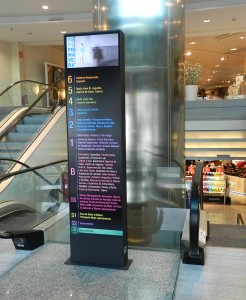
- una sola pantalla de 46” en vertical
- dos pantallas de 46” tipo “videowall” en vertical, a una sola cara y unidas por su lado más corto
- dos pantallas de 46” verticales opuestas (una por cada cara), también con el reproductor integrado.
La colocación típica es en el interior de los accesos y muestran principalmente los directorios de las plantas.
In this case, los ordenadores reproductores son desarrollos específicos adaptados a requerimientos muy particulares que han sido diseñados y fabricados en su totalidad también por Inves. La comunicación, aquí ahora es por cable de fibra óptica, para conectarse a la red interna.
Este es un proyecto llevado a cabo por el grupo de empresas de tecnologías de la información de El Corte Inglés, con instalación y puesta en marcha a cargo de Ruybesa.
El futuro
La implantación ha comenzado coincidiendo con la remodelación de la planta baja del edificio del Paseo de la Castellana de Madrid, tras la anexión a este centro del recientemente construido Titania, ha seguido con el nuevo centro de Córdoba y seguirá aprovechando nuevas inauguraciones y remodelaciones de centros.
Como es lógico, un proyecto de largo recorrido como este, evolucionará con la incorporación de las nuevas tecnologías que vayan apareciendo. Un ejemplo de ello es la puesta en marcha de un proyecto piloto de “medición de audiencias” que, con la integración de la solución “Intel AIM Suite”, permitirá determinar los tiempos óptimos de permanencia de cada imagen para conseguir el mejor resultado y analizar los perfiles y actitudes de los clientes que pasen o se detengan delante de los dispositivos de visualización.
You liked this article?
Subscribe to us RSS feed And you won't miss anything.
• Section: Study cases, OUTSTANDING, Outstanding Case Study, Digital signage, Display, Dynamic advertising



